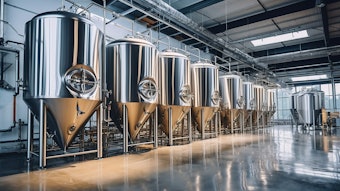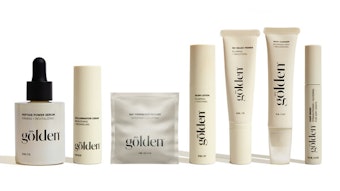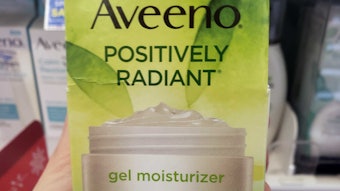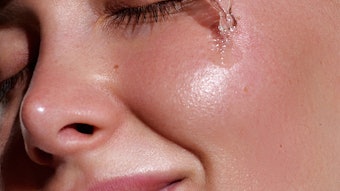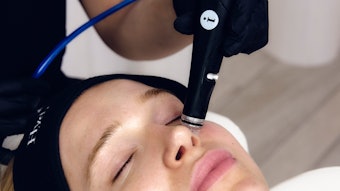Aquaporins are proteins that reside in the cellular membrane. In response to osmotic forces, they control the passage of specific materials into and out of the cell. As reported previously in Cosmetics & Toiletries magazine,1 one type of aquaporin in human skin is aquaporin-3 (AQP3), a pore by which water, glycerin and certain other moisturizing agents gain access to the interior of epidermal cells. The importance of moisturization for skin health and appearance means that personal care companies have a reason to be interested in the activity or presence (expression) of aquaporins, especially AQP3. As reported in the technical literature, four personal care companies have studied the world of biochemicals to discover AQP3 stimulators from three different sources: vitamins, steroids and sugar alcohols.
Vitamins
A vitamin is an organic compound that an animal, plant or other organism needs but cannot synthesize for itself, so it must be obtained from the diet. Thus, the term is conditional both on the circumstances and the particular organism. For example, ascorbic acid functions as vitamin C for some animals but not others, and vitamins D and K are required in the human diet only in certain circumstances, such as liver or kidney disorders in the case of vitamin D and intestinal damage in the case of vitamin K.2
Vitamins serve diverse biochemical functions. For example, vitamin D acts as a hormone. Vitamin E is an antioxidant. Vitamin A regulates cell and tissue growth and differentiation.2
Vitamin B3, also known as niacin, in the form of niacinamide plays a role in AQP3 stimulation and has been investigated at the upstream research division of Procter & Gamble (P&G) Beauty. A 2007 US patent application3 from P&G discloses personal care compositions comprised of at least one ingredient from each of two ingredient groups in a dermatologically acceptable carrier. One group consists of niacinamide, glycerin and mixtures thereof. The other group consists of aquaporin-stimulating compounds—of which 40 are named—and their mixtures. Some of the aquaporin-stimulating compounds mentioned in that patent are well-established cosmetic ingredients, such as caffeine, green tea, menthol, tea tree oil and kinetin. Others, such as Ajuga turkestanica extracts and various ginsenoside compounds (components of ginseng extract), also were disclosed. This work from P&G Beauty was described previously.4
Vitamin A, or retinoic acid, has been studied at Johnson & Johnson Consumer France SAS.5 Researchers there investigated the in vitro and ex vivo effects of all-trans retinoic acid (ATRA) on AQP3 expression and function. An ATRA treatment was found to provoke a rapid accumulation of AQP3 transcripts in cultured normal human epidermal keratinocytes (NHEK). This increase was observed as long as 24 hr after application of ATRA. The induction of AQP3 gene was accompanied by an augmentation of immunoreactivity. Incubation of NHEK in ATRA for 24, 48 and 72 hr stimulated glycerol influx, suggesting that the increase in AQP3 gene and protein expression was followed by an enhancement of biological activity. Topical application of ATRA for 24 hr on skin explants induced significant epidermal expression of AQP3 and strong immunoreactivity in the epidermal basal layers. According to the authors, these results show that ATRA increased AQP3 expression and enhanced biological activity in human skin.
Nicotinamide is yet another name for vitamin B3. Chinese researchers have shown6 that while ATRA upregulates AQP3 expression in cultured human skin keratinocytes (HaCaT cells), nicotinamide attenuates the effect of ATRA in a concentration-dependent manner. This study provides insight into the molecular mechanism through which nicotinamide reverses the side effects of dryness in human skin after treatment with ATRA.
Steroids
A steroid is a terpenoid lipid characterized by a carbon skeleton with four fused rings, generally arranged in a 6-6-6-5 fashion. Steroids vary by the functional groups attached to these rings and the oxidation state of the rings. Hundreds of distinct steroids are found in plants, animals and fungi. Among the many steroids are the hormones estrogen, progesterone and testosterone.
All steroids are made in cells either from the sterol lanosterol (animals and fungi) or the sterol cycloartenol (plants). Both sterols are derived from the cyclization of the triterpene squalene, the natural compound that, when hydrogenated, is called squalane, a common ingredient in personal care formulations.
In a 2003 dissertation,7 a Swedish researcher addressed the question of whether there might be factors in the skin that could influence the rate and direction of water transport through perinatal skin. His investigation focused on aspects of water transport through developing skin, first by determining TEWL in a group of extremely preterm infants. Further, in an experimental rat model, he analyzed the expression and distribution of AQP in the perinatal skin in relation to biophysical parameters of the skin barrier such as TEWL, skin surface hydration and the water content of the skin. The investigation included an analysis of developmental aspects as well as the effects of a clinically relevant form of pharmacological treatment, namely antenatal corticosteroids. He found that antenatal corticosteroid treatment induces functional changes in the skin of preterm rat pups, resulting in a lower TEWL, lower skin surface hydration, and a lower water content of the skin. These changes occur in parallel with an upregulation of AQP3 in the epidermis.
For more than a decade, ecdysteroids have interested researchers at LVMH Recherche-Parfums et Cosmétiques. A 1997 patent8 issued to LVMH described the use of an ecdysteroid for the preparation of cosmetic or dermatological compositions intended specifically for strengthening the water barrier function of human skin. Ecdysteroids are hormones that regulate keratinocyte differentiation in humans. This differentiation manifests itself at the epidermal level in greater cellular cohesion; in the regulation of keratinocyte transformation into corneocytes, through loss of the nucleus and increase in cellular cornification; and in an increase in the number of layers of corneocytes forming the cornified layer.
A 2006 LVMH patent9 disclosed that by selecting particularly polar solvent media for the plant Ajuga turkestanica it is possible to obtain ecdysteroids and other active ingredients whose associations make it possible to improve the differentiation of keratinocytes, which in turn makes it possible to improve the hydration of the skin and obtain a particularly effective antiaging activity. Furthermore, the inventors observed that the extracts and the associations of these ingredients are particularly effective in regulating the water fluxes in the epidermis, an activity that the inventors relate to the activity of the extracts in the regulation and/or functionality of AQP3, thereby affording a better hydration of the basal layers of the epidermis. Examples of formulations containing ecdysteroids were previously reported.10
Sugar Alcohols
A sugar alcohol—also known as a polyol—is a hydrogenated form of carbohydrate whose carbonyl group (aldehyde or ketone, reducing sugar) has been reduced to a primary or secondary hydroxyl group. Sugar alcohols are commonly used for replacing sucrose in foodstuffs. Examples of sugar alcohols include glycerol, also known as glycerin, as well as glycol, xylitol, sorbitol and others. It has been known since 1994 that AQP3 is an aquaglyceroporin, meaning that it is permeable to both water and glycerin. Curiously, Japanese researchers recently identified a regulator factor for the transcription of AQP3, whose expression is repressed by insulin.11
A recent Beiersdorf patent12 discloses cosmetic and dermatological preparations comprising aquaporin stimulators, especially glyceryl glycosides, and the use thereof for improving moisturization of the skin. A glycoside is any of a group of sugar derivatives, widely distributed in plants, that upon hydrolysis yields a sugar and one or more other substances. Many plants store important chemicals in the form of inactive glycosides; when these chemicals are needed, the glycosides are brought in contact with water and an enzyme, and the sugar part is broken off, making the chemical available for use. In a glyceryl glycoside, the sugar part is bound to glycerol by a condensation reaction.
“The particular glyceryl glycoside preferred by Beiersdorf is glyceryl glucoside, a term used in the specific case of glucose bound to glycerin,” said Cathrin Scherner, PhD, senior research scientist, Active Ingredient Profiles at Beiersdorf Research Center, in Hamburg, Germany.
“Glucose is linked to glycerin by a glycosidic bond of the amoneric oxygen. These kinds of monosaccharides are characterized by their hydrophilicity,” Scherner told C&T magazine. “Glyceryl glycosides have been widely known for many years. In particular, extremophile plants and different cyanobacteria produce glyceryl glycosides for osmotic adjustment in order to be able to survive in extremely dry or salty environmental conditions.” Structures of two glyceryl glucosides are shown in Figure 1. Some organisms produce the 1-O-isomer; others produce the 2-O-isomer.
“Various glyceryl glucosides were designed and synthesized by Beiersdorf to confer specific structural and osmotic properties in regard to their potential to stimulate AQP3 mRNA expression leading to an improved moisturization of the skin,” explained Ute Breitenbach, PhD, one of the inventors and a lab manager of the Laboratory of Dry Skin/Skin Care at Beiersdorf’s Research Center in Hamburg.
“In a large screen of actives using human keratinocytes we analyzed the AQP3 stimulation potential of glyceryl glucoside in relation to glycerol because we were trying to identify new active moisturizers better than glycerol,” Breitenbach said. “We observed a significant increase in AQP3 mRNA levels by the application of glyceryl glucoside” (see Figure 2).
“These glyceryl glucosides were not new to Beiersdorf. They had been in the company patent literature since 1997 as agents that enhance skin moistness,” Breitenbach said, referring to an earlier patent.13 “But their potential of stimulating AQP3 expression and thereby the activating the skin’s own water channels from within was a discovery.”
Preparations according to the invention preferably contain 0.1–5% by weight of the glyceryl glycoside. Osmotic stress is known to upregulate AQP3 expression.14 By adding substances to trigger osmotic stress—substances such as inorganic salts, and salts of the naturally occurring skin acids or weak carboxylic acids—the AQP3 stimulation capacity can be further increased.
Comment
This “Bench & Beyond” column and the three that preceded it focused on compounds that can be introduced into the skin to stimulate AQP3 expression. These compounds work directly on the aquaporin, and there are numerous examples—caffeine, sugars, vitamins—that work in this way. Much rarer in the literature are compounds—such as certain salts and acids—that stimulate AQP3 expression by the indirect route of osmotic stress. Only one such paper14 was found in the research for this column. Perhaps studies on the means of more precisely regulating osmotic stress in the skin will be the next frontier in aquaporin research.
Reproduction of all or part of this article is strictly prohibited.
References
Send e-mail to [email protected].
1. B Brewster, Aquaporins: The one-molecule-at-a-time moisturizer, Cosmet Toil 123(5) 24–32 (2008)
2. https://en.wikipedia.org/wiki/Vitamin (Accessed Sep 1, 2008)
3. US Pat Applic 20070009474, Personal care compositions and methods for the beautification of mammalian skin and hair, S Xie et al, assignedto The Procter & Gamble Company (Jan 11, 2007)
4. B Brewster, Aquaporins: Stimulating AQP3, Cosmet Toil 123(6) 20–26 (2008)
5. G Bellemère, O Von Stetten and T Oddos, Retinoic acid increases aquaporin 3 expression in normal human skin, J Invest Dermatol 128(3) 542–548 (2008)
6. X Song et al, Nicotinamide attenuates aquaporin 3 overexpression induced by retinoic acid through inhibition of EGFR/ERK in cultured human skin keratinocytes, Int J Mol Med 22(2) 229–236 (2008)
7. J Ågren, Water transport through perinatal skin: Barrier function and aquaporin water channels, a dissertation from the Faculty of Medicine, Uppsala University, Uppsala: Acta Universitatis Upsaliensis (2003)
8. US Pat 5,609,873, Use of an ecdysteroid for the preparation of cosmetic or dermatological compositions intended, in particular, for strengthening the water barrier function of the skin or for the preparation of a skin cell culture medium, as well as to the compositions, A Meybeck, F Bonte and G Redziniak, Assigned to LVMH Recherche (Mar 11, 1997)
9. US Pat 7,060,693, Ajuga turkestanica extract and its cosmetic uses, M Dumas, F Bonte and C Gondran, Assigned to LVMH Recherche (Jun 13, 2006)
10. B Brewster, Aquaporin-3: Regulating skin cell growth, Cosmet Toil 123(10) 22-27 (Jun 2008)
11. S Higuchi et al, Transcriptional regulation of aquaporin 3 by insulin, J Cell Biochem 102(4) 1051–1058 (2007)
12. WO/2007/124991, Cosmetic preparation with aquaporin stimulators and the use thereof, U Breitenbach et al, assigned to Beiersdorf AG (Nov 8, 2007)
13. EP0770378, Cosmetic preparations with an effective amount of glycosyl- glycerides, J Thiem, O Scheel and G Schneider, Assigned to Beiersdorf (Feb 5, 1997)
14. Y Sugiyama et al, Osmotic stress up-regulates aquaporin-3 gene expression in cultured human keratinocytes, Biochim Biophys Acta 1522(2) 82–88 (2001)
